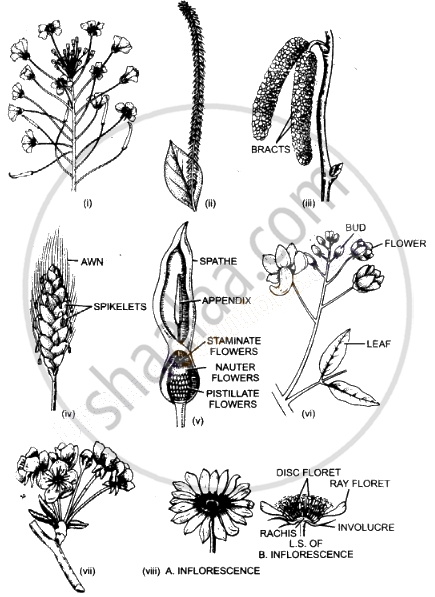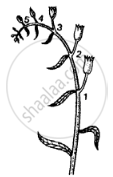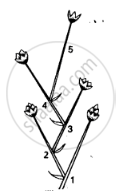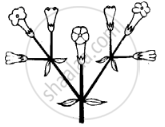Advertisements
Advertisements
Question
Explain the basis for the different types of inflorescence in flowering plants.
Answer in Brief
Solution

- Racemose inflorescence: Various types of spices live in the fly of the flower axis. The flowers are immersed in an anterior arrangement. The flowers at the bottom are bigger and the flowers at the top are smaller, respectively. Cotyledon inflorescences are of the following types:
- Cymose: In this, there are petioled and cotyledonous or non-cotyledonous flowers on the main flower axis; Like in radish, mustard, larkspur, etc.
- Spike: Intact flowers include sessile flowers; Like in Amaranth, chirchita, etc.
- Manjari: It has a flower axis and a florida. It bears unisexual and petal-shaped flowers; Like mulberry, salix, etc.
- Spikelet: These are actually tiny spikes. These usually have one to three flowers. The flowers are surrounded by sepals at the base; Like in wheat, barley, oats, etc.
- Gross Manjari: In this, the floral axis is pulpy and has sessile, unisexual flowers. The apical sterile part of the floral axis is called the appendix. On the floral axis, there are female flowers at the bottom, sterile flowers in the middle and male flowers at the top. The flowers are covered with colourful nectaries; Like in banana, palms, arvi, etc.
- Samashikha: In this, the main axis is short. The flower stalks of the lower flowers are longer and those of the upper flowers are shorter. Due to this, all the flowers are located at almost the same height; Like in candytuft, cassias, etc.
- Flower Umbrella: In this, the flower axes are very small. All the flowers appear to emerge from the same point and form an umbrella-like structure. It has bigger flowers towards the periphery and smaller flowers towards the centre; Like coriander, cumin, fennel, cumin, etc.
- Mundak: In this, the floral axis has a flattened effect. There are two types of flowers on it. Ray florets towards the periphery and image florets in the nucleus. The entire inflorescence looks like a single flower; like a sunflower, marigold, zinnia, dahlia, etc.
- Terminalia florets: In this, growth stops when the anterior bud of the floral axis develops into a flower. Lateral branches emerge from the nodes below and form flowers. For this reason, the order of appearance of flowers is downward. In this, the central flower is big and old and the flowers below are small and new. The terminal inflorescences are of the following types:
- Unibranch terminal: In this, the floral axis ends in a flower. Only one lateral branch is produced from the node at a time, on which a flower is formed. Lateral branches emerge in two ways
- When all the lateral branches emerge in the same direction, it is called Kundalini, which forms an unibranched border; Like in Makoy, Begonia, etc.
- When the lateral branches emerge in alternate order, it is called the terminal apex of the Scorpio unibranch. Like- Heliotropium, Ranunculus, etc.
- Gametium terminal: In this, when the floral axis ends in a flower, two lateral branches develop from the node below and form a flower; Like in Dianthus, Stellaria, etc.
- Multi-branched border: In this, when the floral axis ends in a flower, many branches come out from the node located below and form a flower like in Hemilia, Aak, etc. (It looks like a beehive, but its central flower is larger and the peripheral flowers are smaller).
- Unibranch terminal: In this, the floral axis ends in a flower. Only one lateral branch is produced from the node at a time, on which a flower is formed. Lateral branches emerge in two ways
 |
 |
| i | ii |
 |
 |
| iii | iv |
cymose inflorescence - (i) Kundalini form unibranch, (ii) Scorpio unibranch, (iii) polybranch; (iv) multibranch terminal inflorescence.
shaalaa.com
The Inflorescence
Is there an error in this question or solution?
Chapter 5: Morphology of Flowering Plants - Exercises [Page 83]
APPEARS IN
RELATED QUESTIONS
Differences between racemose and cymose inflorescence.
Define the term inflorescence.
In an inflorescence where flowers are borne laterally in an acropetal succession, the position of the youngest floral bud in the floral axis shall be ______.
The arrangement of flowers on the floral axis is termed as
Inflorescence is
Cymose inflorescence is present in ______.
In the racemose type of inflorescence, the main axis ______.
